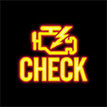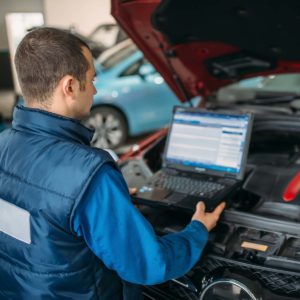Our work is backed by a 3-year, 36,000-mile warranty. Click here to see our warranty details.
Check Engine Light Service
You are on your way to work, or taking the kids to school, and you notice a new warning light on your dashboard. You’ve seen it blink before, but it’s always gone off. Now it’s on steady. What to do? Different manufacturers use have slightly different icons, but normally look similar to one of the icons on the right.
Before contacting your local auto repair shop, it's a good idea to familiarize yourself with the nature and severity of various check engine warnings.
Schedule Your Next Auto Repair Appointment
Let's get your vehicle running right.
Liberty St: (734) 769-0170
Jewett Ave: (734) 769-0380
Liberty St: (734) 769-0170
Jewett Ave: (734) 769-0380
When a warning light comes on, especially if you haven’t seen it before, it’s a good idea to remember this rule of thumb: If the light is RED, it’s probably a good idea to pull over immediately and consult your owner’s manual to determine what it means. Most of the time, a red warning indicator is telling you of a critical malfunction that would either cause damage to an important component (low oil in the engine, for example) or a safety system (your brakes, for example) that might prevent the vehicle from keeping you safe. If you determine that it’s a critical system – engine lubrication, brake system, etc. We recommend that you stop driving immediately and have the vehicle checked out by a professional right away. If you aren’t sure if your car should be driven or not, please call Convenience Auto Service. We will be happy to advise you. Your owner’s manual also likely can provide guidance. Don’t take a chance with your safety, or doing significant harm to the vehicle. Any time a red light is on, we recommend to err on the side of caution.
However, if the light is yellow – the most common cause is what we call a “Check Engine Light,” or Malfunction Indicator Light – MIL. See the examples above. If your check engine light comes on, and your vehicle still runs OK, it is usually safe to drive and will not cause prolonged damage by driving it until you can bring it in to have it serviced. Don’t wait too long, however.
What Causes the warning light to turn on?
Modern cars and trucks contain very complex computers and sensors that monitor engine performance. They control the fuel-air mixture (inputs) and hence the exhaust gasses (outputs) to make sure that the actual combustion process occurs with the correct stoichiometry (chemistry) so as to emit the minimum amount of pollutants into the atmosphere. As part of the Clean Air Act, those great guys at the EPA mandated that all vehicles after 1996 be equipped with OBD or ‘onboard diagnostics.’ The EPA believed that in the 1980s emission controls either failed or became worn out on cars, and motorists didn’t realize it. They mandated that carmakers equip every vehicle built after January 1996 should have built-in electronics that would monitor key emission systems and alert the driver when bad things happened. Hence the “Check Engine” warning light was born. The causes for the light to come on can come from many different types of failures, many simple and inexpensive to correct (a gas cap that isn’t tight enough) or fairly complex (one particular cylinder not firing correctly) or expensive ones (catalytic converter plugged).
A common misconception is that when the check engine light comes on, the technician simply connects an inexpensive OBD II scanner, and it indicates exactly what is wrong with the vehicle. Many auto parts stores (in the business of selling you parts) offer a free check engine light scan. We will also do a scan like this while you wait, and free. In the case of a simple issue, such as a loose gas cap, we can recommend the fix, and send you on your way. However, if the issue is more complex, a more sophisticated regimen of testing and diagnostic process is required. This is particularly true if your problem is intermittent. Driving around for months with the light on also invites more than one problem, which also complicates the repair.
Why do auto parts stores offer to read ‘check engine light codes’ for free?
Parts stores are in business to sell parts. There is nothing wrong with this, and most parts stores in Ann Arbor are honest and do right by customers. However, parts stores’ capabilities tend to be very limited. By law, a business is not permitted to perform diagnosis or offer diagnostic advice without being licensed as a repair facility. They can download codes, and then it’s up to you to determine what you need. As will be explained below, it’s not often that the exact reason a check engine light is on can be determined simply by reading OBD codes. Here is an example of the most simple (and common) type of OBD code – evaporative emissions failure code could be caused by any of the following issues:
- Loose gas cap
- Defective EVAP solenoid
- Leaky or contaminated carbon canister
- Leaky or damaged hoses between the carbon canister and the tank
Typically, the OBD codes won’t pinpoint the problem. If you do have this code, it probably makes sense to make sure your cap is tight, clear the code, and wait before spending money. If the light comes on again in a week or so, a more focused diagnostic process will be required to fix it.
Our typical diagnostic process involves these steps:
1. Compile data – We would use a complex scan tool that is capable of downloading manufacturer-specific diagnostic codes. This tool goes significantly beyond what an OBD II scanner can read. These tools read more exact information and take advantage of all of the diagnostic information the manufacturer provides. This process takes additional time and goes well beyond the ‘free scan’ offered by auto parts stores.
2. Freeze Frame Data – if your issue is intermittent, we can interrogate the engine electronic controls, many of which have what might be regarded as a flight data recorder. It allows the technician to look back in time and see what individual sensors and actuators are doing when a malfunction occurs. As you can imagine, this requires specific training for the technician, as well as more sophisticated equipment.
3. Making sure your software is up to date – there are times when manufacturers recognize that the software they supplied with your vehicle was sub-optimal, and they update it to improve performance. We subscribe to real-time databases that provide us with this information.
The bottom line: Just ‘pulling codes’ normally won’t provide enough insight for a technician to accurately determine what is wrong with your vehicle. While this might be a reasonable first step, it rarely is the final step.
Once the specific system or fault is determined, circuit or pinpoint testing is the logical next step. This isolates the actual faulty component or wiring issue. We do this with the help of up to date wiring diagrams, electrical or mechanical tests, and visual inspection. We also typically consult manufacturer databases to make sure that relevant factor technical service bulletins have been performed.
Once the particular system is isolated, faulty components or wiring can be replaced or repaired. We then verify that the repair had the intended positive impact on vehicle performance. One thing we’ve learned from years of experience. It normally takes much longer to determine the specific issue or component that has failed than it does to replace that component. That is why we typically include a diagnostic charge for check engine light work.
Verification
A key element in your satisfaction is “Fix it right the first time.” This isn’t always easy, especially when the issue is intermittent. For that reason, we typically spend time verifying that the issue is fixed. This might include putting the old part back on (A-B-A substitution) or similar process to make sure that the problem is fixed, and will stay fixed.
As always, your satisfaction Is our prime concern. Fixing complex electrical or mechanical issues requires the requisite diagnostic tools and technicians that possess the training and experience to quickly determine the issue, and fix your car right the first time, on time. We are proud of the ASE certifications our Licensed MASTER technicians have earned. We also are appreciative of the trust you place in us. We value your business. Thanks for being our customer.
Why Choose Us for Auto Repair in Ann Arbor
Convenience. Peace of mind.
Experience
Proud to be locally owned in Ann Arbor for nearly 20 years.
Expertise
Honest, knowledgeable staff. ASE certified technicians.
Value
Our 3 year, 36000 mile warranty offers you the best value in town!
Trusted Work
Unsurpassed reputation in Ann Arbor, Michigan, and Washtenaw County. Check out our ratings on Google!
High Quality
Skilled ASE certified technicians. that care about you and your car.










